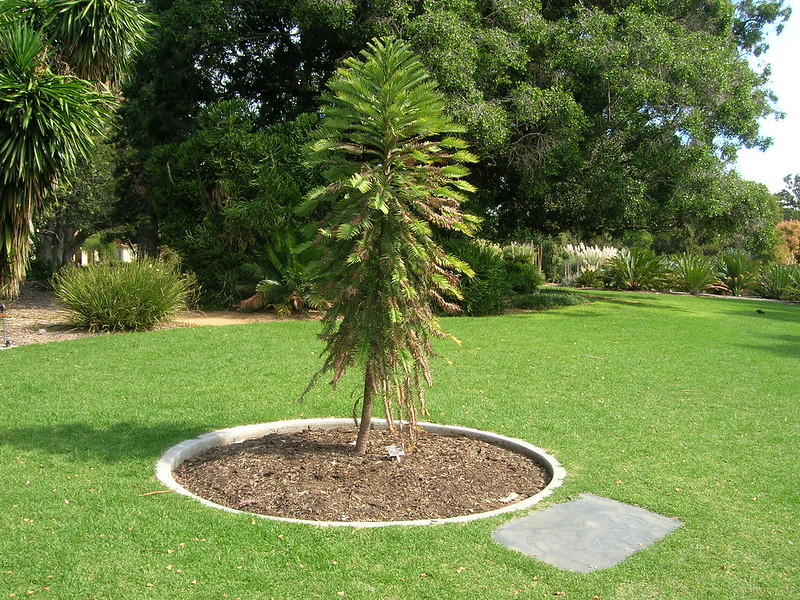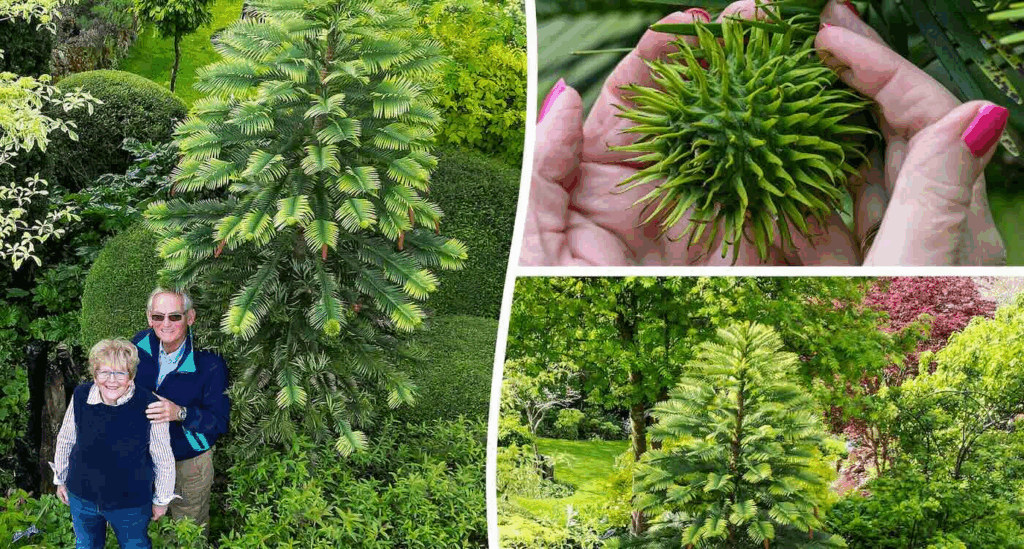Ancient Tree That Once Grew During Dinosaur Era Bears Fruit for the First Time-in a Retired Couple’s Yard

Imagine planting a tree in your backyard—only to discover, years later, that it once shared the Earth with dinosaurs.
Its ancestors shaded the feet of Tyrannosaurus rex. Its cones may have been chewed by creatures long since vanished into fossil records. And now, here it stands—alive, growing, and bearing fruit—not in some remote jungle, but in the quiet garden of a retired couple in Worcestershire, England.
This isn’t a scene from science fiction. It’s the true story of the Wollemi pine, one of the rarest and most ancient trees on Earth, thought to have gone extinct over 90 million years ago. Until, one day, it didn’t.
How does a living relic from prehistory find its way into modern suburbia? And what does it mean when such a tree—once wiped from time—begins to bear new fruit, against all odds?
The answers are as much about science and survival as they are about hope, patience, and the quiet power of everyday people. Because sometimes, the most extraordinary stories don’t begin in labs or headlines—they begin in someone’s backyard.
The Rediscovery of a Living Fossil
Long before humans built cities, wrote books, or dreamed of flight, the Wollemi pine stood tall in ancient forests. It witnessed continents drift, climates shift, and entire species vanish—including the dinosaurs. For more than 90 million years, it endured in silence, until the world presumed it gone.
Then came 1994.
In a remote canyon just 125 miles west of Sydney, Australia, a park ranger named David Noble rappelled into an unexplored gorge in Wollemi National Park. What he found stunned the scientific world—a grove of unusual conifers, unlike anything modern botany had recorded. DNA analysis confirmed the impossible: Noble had discovered living Wollemi pines, a genus known only through fossils dating back to the time of the dinosaurs.
It was as if the fossil record had come to life.
There is something quite magical about the new growth on our wollemi pine in the late evening sunshine 🌞 pic.twitter.com/kkAEf6a3SH
— Mike Clifford (@MikesRarePlants) June 16, 2024
Dubbed a “living fossil,” Wollemia nobilis instantly joined the ranks of the most extraordinary botanical finds of the century. Its discovery was likened to finding a living dinosaur, not just because of its ancient origins, but because of how completely it had escaped human notice for so long. Hidden in a steep, misty gorge, this prehistoric survivor had clung to existence while empires rose and fell.
Physically, the Wollemi pine looks like no other tree. Its bark has a distinctive, knobbly texture, almost like chocolate mousse, and its flat, fern-like leaves spiral elegantly around soft, flexible branches. Unlike most conifers, it can produce multiple trunks from a single root system, growing up to 130 feet tall in its natural habitat. Some wild specimens are believed to be over 1,000 years old.
But its rarity is what makes it almost mythical. At the time of discovery, fewer than 100 mature Wollemi pines existed in the wild. Their exact location remains top secret to this day, to protect them from human interference, disease, and illegal harvesting. Classified as critically endangered, their survival depends on both intense in-situ protection and global propagation efforts.
The Thompsons’ Garden Journey

Image Credits: https://www.goodnewsnetwork.org/
It began, like many extraordinary stories, with a modest act and no idea what it would become.
In 2010, Pamela and Alistair Thompson, a retired couple living near the Malvern Hills in Worcestershire, attended a local charity auction. Among the items up for bid was a small, 18-inch sapling—a Wollemi pine. A friend had bought it from a TV shopping channel, unaware of just how rare and ancient the tree truly was. The Thompsons, longtime gardening enthusiasts, saw something special in it and took it home for £70.
What they didn’t know then was that they weren’t just planting a tree—they were adopting a survivor of the prehistoric world.
Over the next 14 years, their backyard became a sanctuary. The sapling slowly transformed into a towering specimen over 13 feet tall, nestled quietly in their English garden. Every season brought careful tending, and every year carried with it a silent hope. Though they knew their Wollemi pine was rare, they never imagined it would one day make history.
Then, this spring, something astonishing happened.
Pamela noticed something different among the branches—clusters of long, hanging male cones and round, spiky female cones growing simultaneously. For the first time ever, a Wollemi pine outside of its native Australia was showing signs of natural reproduction. In botanical terms, this was groundbreaking. But for the Thompsons, it was deeply personal—like discovering that a child they’d nurtured had begun to create a legacy of its own.
“It’s like expecting panda babies,” Alistair said with a smile, describing the anticipation of waiting to see if seeds would form. Pamela compared their daily routine of checking the cones to children rushing downstairs on Christmas morning.
Their joy wasn’t rooted in fame or recognition—it was in awe. In wonder. In the quiet thrill of being custodians of something ancient, fragile, and fiercely alive. And now, with the tree entering a phase of potential reproduction, the Thompsons have become unexpected stewards in one of the planet’s most remarkable conservation stories.
Conservation, Genetic Diversity, and Global Significance

Since its dramatic rediscovery in 1994, conservationists have faced a major challenge: while cloning Wollemi pines helped rapidly increase their numbers, it created a genetic bottleneck. Clones are, by nature, genetically identical. And while that uniformity makes reproduction fast, it also leaves the species vulnerable. A single disease or environmental shift could wipe out entire populations with little resistance.
That’s why the appearance of both male and female cones—and potentially viable seeds—on the Thompsons’ tree is so significant. Natural reproduction introduces genetic variation, the raw material of evolution and resilience. Each seed that forms from this process could carry a unique genetic blueprint, strengthening the species’ adaptability in a rapidly changing world.
Botanical experts from institutions like Kew Gardens have praised this development as a hopeful sign. If these seeds are viable, they represent more than just a novelty—they’re a new chapter in the fight to preserve the Wollemi pine not as a museum piece, but as a living, evolving species.
This breakthrough also underscores the value of “ex situ” conservation—protecting species outside their natural habitats. By growing Wollemi pines in private gardens and public arboretums across different climates and regions, scientists and citizens alike help shield the species from localized threats like bushfires, pathogens, and illegal poaching. This strategy proved its worth in 2020, when devastating wildfires swept through parts of Wollemi National Park, nearly destroying the few known wild groves. Specialized firefighting units were deployed to protect them, but it was a wake-up call: relying solely on wild populations was no longer safe.
The Thompsons’ tree is now part of a growing international safety net. And its fruiting suggests that this ancient species, given the right conditions and care, can not only survive but regenerate—far from the secret canyons of Australia.
Human Connection to the Natural World

There’s something profoundly humbling about standing before a tree that predates human civilization—let alone human existence. The Wollemi pine is more than just a scientific marvel; it’s a living reminder of how deeply interconnected we are with the natural world, even when we forget to notice.
For Pamela and Alistair Thompson, their Wollemi pine isn’t just a rare botanical treasure—it’s become a companion in their retirement, a daily ritual, a quiet teacher. In caring for it, they’ve tapped into something that so many of us, in a world of constant notifications and artificial urgency, are missing: stillness, stewardship, and awe.
And awe matters.
It’s awe that reconnects us with what’s bigger than ourselves. It’s awe that turns a garden into a sanctuary, a tree into a story, and a hobby into a legacy. When the Thompsons lovingly check on the cones of their “dinosaur tree” each morning, they are not just tending to branches—they are tending to history, hope, and the future of life itself.

Their story also challenges the idea that meaningful impact is reserved for scientists, politicians, or organizations. The truth is, ordinary people, when guided by care and curiosity, can do extraordinary things. The couple didn’t set out to join a global conservation movement. They just planted a tree. And because they paid attention—because they stayed engaged with its slow, quiet journey—that act now echoes across generations and ecosystems.
In opening their garden to the public through the National Garden Scheme, the Thompsons are passing on more than knowledge—they’re passing on inspiration. They invite others to not only witness the living past, but to imagine what’s possible when we choose to care for the living present.
The Wollemi pine teaches us patience. It teaches us humility. But most of all, it teaches us that the world is still full of wonder, waiting just beneath the surface—for those who are willing to look, and willing to listen.
What Legacy Will You Nurture?
The story of the Wollemi pine isn’t just about an ancient tree bearing fruit in a quiet English garden—it’s about what we choose to cultivate in our own lives.
Pamela and Alistair Thompson didn’t set out to make headlines. They simply planted a tree and tended to it with patience, attention, and love. And yet, their care became a vessel for something much larger—a spark of renewal for a species that had outlived empires, only to be saved by two people who paid attention.
In a world obsessed with speed and scale, this story offers a radical truth: legacy is built through presence, not performance.
So ask yourself—what seeds are you planting? What are you nurturing quietly that may one day ripple outward in ways you can’t yet imagine?
Maybe it’s the way you listen. The way you care. The way you protect something vulnerable when no one’s watching.
The Wollemi pine reminds us that some of the most meaningful impacts we can have are slow, unglamorous, and rooted in deep time. And that even when hope seems ancient or forgotten, it can still take root—and bloom—if someone is willing to believe in it long enough.
This isn’t just about trees. It’s about the future we grow—one choice, one act of care, one seed at a time.
Featured Image from brewbooks, Flickr
Loading...

